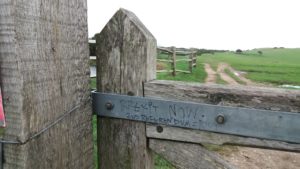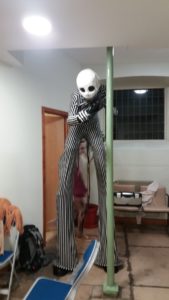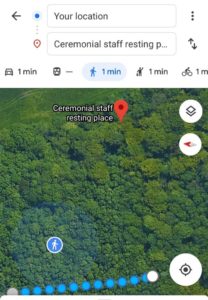 I sometimes go too long without a proper walk. On the last Saturday in October, I needed to go to Lewes for an evening event, so I decided to walk there. There aren’t many routes from where I live – it’s basically Rottingdean/Balsdean or the Juggs Road. In the end, I took the train to Hassocks and walked via Wolstonbury Hill, following the line of the Downs west.
I sometimes go too long without a proper walk. On the last Saturday in October, I needed to go to Lewes for an evening event, so I decided to walk there. There aren’t many routes from where I live – it’s basically Rottingdean/Balsdean or the Juggs Road. In the end, I took the train to Hassocks and walked via Wolstonbury Hill, following the line of the Downs west.
 The climb up Wolstonbury is steep but, even so, I was surprised how hard I found it, and how many times I needed to stop for breath. I’d managed the steps of Swayambunath temple without stopping (thereby gaining enlightenment in this lifetime), but this less remarkable hill proved too much to do in one go.
The climb up Wolstonbury is steep but, even so, I was surprised how hard I found it, and how many times I needed to stop for breath. I’d managed the steps of Swayambunath temple without stopping (thereby gaining enlightenment in this lifetime), but this less remarkable hill proved too much to do in one go.
Wolstonbury is a significant place to me. Every year, on ascension day, my school would climb the hill for a small religious service at the summit. The tradition was taken from an Oxford college when the school was young, in order to give the new institution a feeling of tradition. Standing on the top of the hill, blown about by a strong wind, the scene was very different, much bleaker than the summer day of the ceremony.
I have a weird memory from Halloween when I was 14 or 15, watching lights moving up the dark face of Wolstonbury. There were rumours of black masses being held there. The priest at the final Ascension Day service I attended described the ritual we were performing as a ‘white mass’.
Apparently Wolstonbury once had a chalk figure. The only mention I can find online is one in Hurst Life magazine, which claims it appeared in October 1959 as a rag week stunt. Apparently there is a photo of this figure from the Argus, and another in the Herald. The article goes on to say “(another) chalk lady was cut in Wolstonbury some ten years later”. I went to a National Trust talk a few years back, and I’m sure that they talked about a chalk figure that was placed on the hill by soldiers, who were training nearby for D-Day. Sadly, a new job means it will be some time before I can look into this any further.
From Wolstonbury I headed East, following the South Downs way towards Lewes. I’d done the route before a number of times and it felt slightly unengaging on such an overcast, blustery day. The ground was damp and there was little shelter from the wind, so I didn’t bother with any seated stops.
And, of course, the walk was haunted by Brexit. Someone had written slogans of protest on the gates near Ditchling Beacon. Some of it was depressingly racist, and I don’t know if it was the heartfelt pleas of a racist or a random troublemaker. But Brexit keeps intruding on my walks.
Sometimes, when I am walking alone I take it too fast, making my feet and legs ache, hurting myself. This was one of those days. I ground out the miles, wanting to reach Lewes ahead of the rain. I ran out of walk long before I ran out of time.
The only problem was, I’d arrived about four hours earlier than planned. So, I headed to the venue for the night’s event and sat quietly in a corner reading. It was fun to watch the show come together, and helping out when needed. The show was awesome – aerial, contortionists and dancers. But my favourite act was the roller-skate/hula act. Even on a small stage, the performer glided and flowed. It was a good day.


















